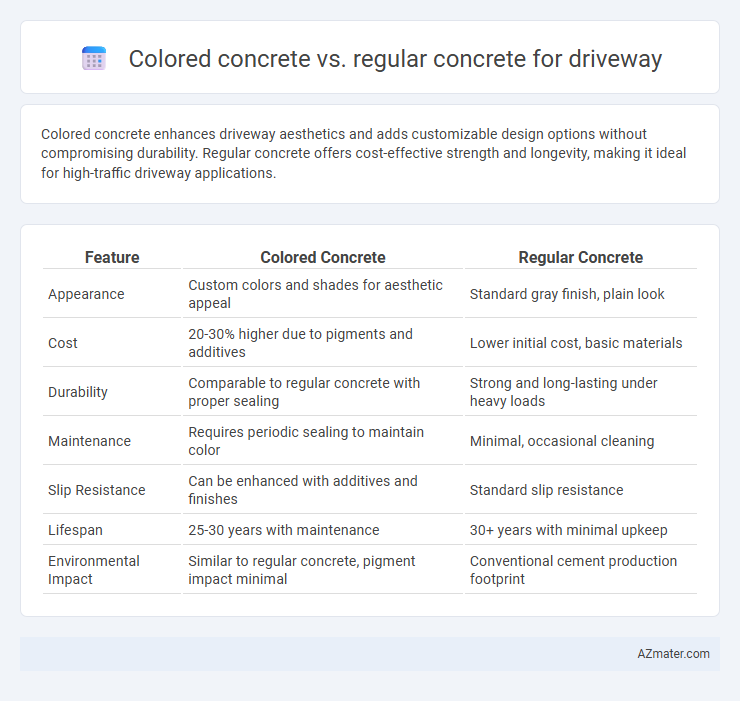Colored concrete enhances driveway aesthetics and adds customizable design options without compromising durability. Regular concrete offers cost-effective strength and longevity, making it ideal for high-traffic driveway applications.
Table of Comparison
| Feature | Colored Concrete | Regular Concrete |
|---|---|---|
| Appearance | Custom colors and shades for aesthetic appeal | Standard gray finish, plain look |
| Cost | 20-30% higher due to pigments and additives | Lower initial cost, basic materials |
| Durability | Comparable to regular concrete with proper sealing | Strong and long-lasting under heavy loads |
| Maintenance | Requires periodic sealing to maintain color | Minimal, occasional cleaning |
| Slip Resistance | Can be enhanced with additives and finishes | Standard slip resistance |
| Lifespan | 25-30 years with maintenance | 30+ years with minimal upkeep |
| Environmental Impact | Similar to regular concrete, pigment impact minimal | Conventional cement production footprint |
Introduction to Colored and Regular Concrete Driveways
Colored concrete driveways offer enhanced aesthetic appeal by integrating pigments directly into the mix, creating a durable and visually striking surface resistant to fading and wear. Regular concrete driveways are composed of cement, water, and aggregates, providing a cost-effective, strong, and versatile foundation with a natural gray appearance. Both options deliver long-lasting performance, but colored concrete allows for customization that complements landscape designs and architectural styles.
Aesthetic Differences: Colored vs. Regular Concrete
Colored concrete offers a wide range of design possibilities with vibrant hues and custom patterns, enhancing driveway aesthetics beyond the plain gray appearance of regular concrete. It resists fading and allows for creative integration with landscaping, providing a visually appealing and personalized driveway surface. Regular concrete, while durable and cost-effective, often lacks the decorative appeal and uniqueness that colored concrete delivers.
Material Composition and Coloring Techniques
Colored concrete for driveways incorporates integral pigments or surface-applied stains to achieve vibrant hues, differentiating it from regular concrete, which typically remains gray. The material composition of colored concrete includes standard cement, aggregates, water, and carefully measured color additives such as iron oxide or synthetic organic dyes that penetrate the mixture or coat the surface. Coloring techniques include integral coloring during batching, surface staining, or applying color hardeners, which enhance durability and aesthetic appeal while maintaining the structural properties essential for driveway performance.
Installation Process Comparison
Colored concrete for driveways requires meticulous mixing of pigments into the concrete blend for uniform color distribution, while regular concrete focuses primarily on the cement, sand, and aggregate mix without additives. The installation of colored concrete demands precise timing for surface treatments like sealing and curing to enhance color retention and durability, contrasting with the standard curing practices of regular concrete. Both types require proper subbase preparation and finishing techniques, but colored concrete installations often involve additional steps to prevent color inconsistencies and fading over time.
Durability and Longevity
Colored concrete for driveways offers enhanced durability due to integral pigments that resist fading and wear compared to regular concrete, which can suffer surface discoloration over time. The addition of colorants and sealers in colored concrete improves UV resistance and reduces the likelihood of cracking caused by weather changes, extending the driveway's lifespan. Studies show colored concrete maintains structural integrity and aesthetic appeal longer, often outlasting standard gray concrete by several years under similar environmental conditions.
Maintenance Requirements
Colored concrete driveways require regular cleaning and occasional resealing every 2-3 years to maintain vibrant hues and protect against fading caused by UV exposure and weather conditions. In contrast, regular concrete demands less frequent sealing but is more prone to visible stains, requiring power washing to address oil or dirt buildup. Both types benefit from prompt crack repairs to preserve structural integrity and aesthetic appeal over time.
Cost Differences and Value for Money
Colored concrete for driveways typically costs 15-25% more than regular concrete due to added pigments and specialized mixing processes. Despite the higher initial expense, colored concrete offers enhanced curb appeal and long-term value by reducing the need for repainting or staining. Investing in colored concrete can increase property value and provide durable, aesthetically pleasing results that justify the upfront cost difference.
Weather Resistance and Performance
Colored concrete used for driveways offers enhanced weather resistance due to integral pigments that maintain color and reduce fading under UV exposure, unlike regular concrete which often requires supplementary coatings for protection. Its performance includes improved durability against freeze-thaw cycles and de-icing salts, making it ideal for climates with extreme weather conditions. Regular concrete, while structurally sound, may experience more surface wear and discoloration over time without additional treatments.
Environmental Impact
Colored concrete for driveways often incorporates recycled pigments and additives, reducing the environmental footprint compared to regular concrete, which typically relies on standard Portland cement with higher carbon emissions. The production of colored concrete can utilize supplementary cementitious materials such as fly ash or slag, lowering greenhouse gas emissions associated with cement manufacturing. Furthermore, colored concrete's durability and enhanced UV resistance extend driveway lifespan, decreasing the frequency of replacement and conserving resources over time.
Choosing the Right Concrete Finish for Your Driveway
Choosing the right concrete finish for your driveway involves balancing aesthetics with durability and maintenance. Colored concrete offers a vibrant, customized look that resists fading and can enhance curb appeal, while regular concrete provides a cost-effective, classic gray surface with excellent strength and longevity. Consider factors such as climate, budget, and desired style to select a finish that meets functional needs and complements your home's exterior.

Infographic: Colored concrete vs Regular concrete for Driveway
 azmater.com
azmater.com